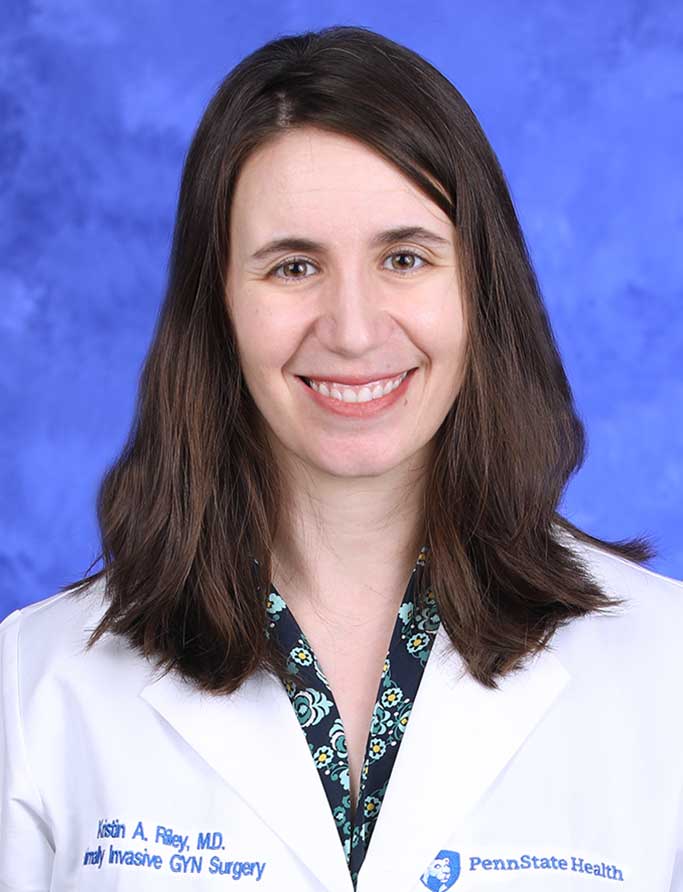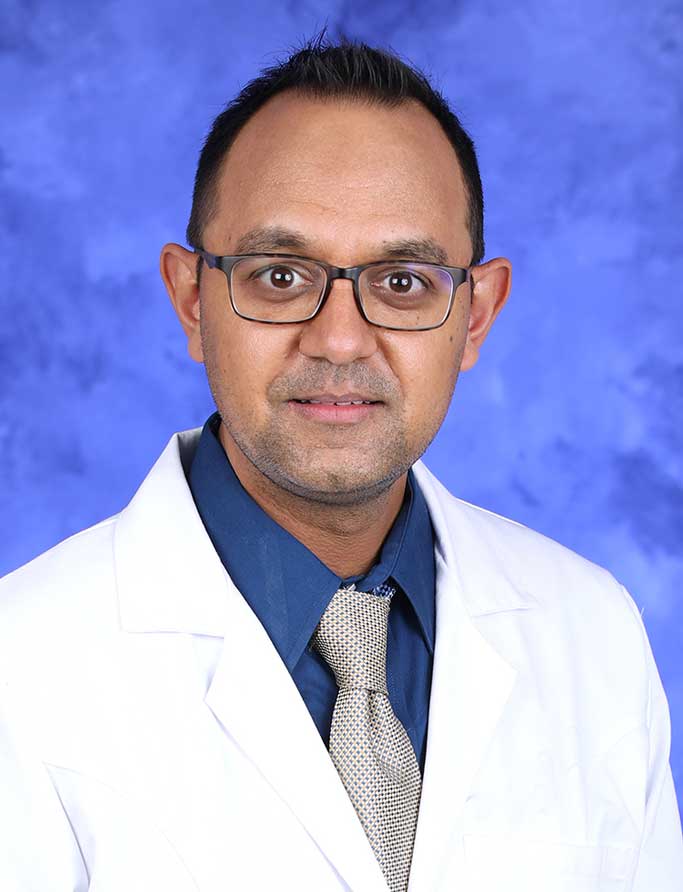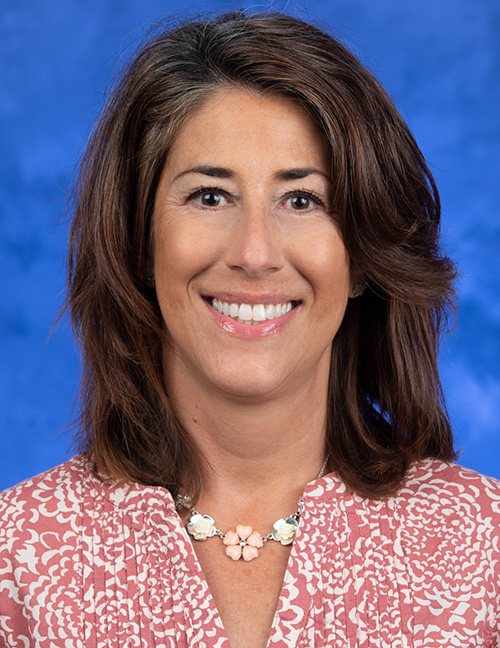Jump to topic
Search
Program Details
The Division of Minimally Invasive Gynecologic Surgery at Penn State Health established an AAGL-approved fellowship in 2010. The program has a three-year curriculum with career development integrated throughout the training process to maximize clinical and surgical experiences as well as research and education. Protected time includes time for research, graduate level coursework and training in teaching. Fellows have approximately 30% career development time in year 1, 80% in year 2, and 40% in year 3.
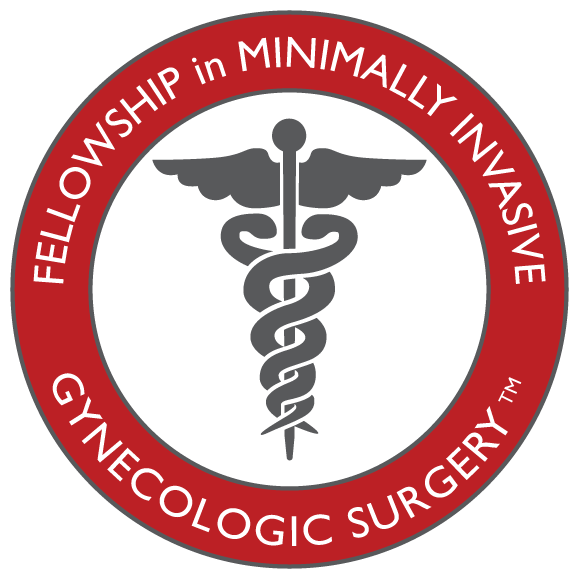 The program offers a high-volume surgical practice utilizing both conventional and robot-assisted laparoscopic platforms as well as vaginal surgery and vNOTES. It includes fellowship-trained MIGS faculty as well as associated OB/GYN faculty from other GYN subspecialties. The surgical service focuses on the management of complex benign gynecologic diseases. The fellowship has a particular interest in pelvic pain with a dedicated multidisciplinary team for Endometriosis and Chronic Pelvic Pain. Penn State Milton S. Hershey Medical Center is a 550-plus-bed academic medical center located in Hershey, Pa. The hospital is equipped with 35 operating rooms, including eight laparoscopic suites. Each fellow has historically averaged more than 350 surgical cases per year during their clinically focused years.
The program offers a high-volume surgical practice utilizing both conventional and robot-assisted laparoscopic platforms as well as vaginal surgery and vNOTES. It includes fellowship-trained MIGS faculty as well as associated OB/GYN faculty from other GYN subspecialties. The surgical service focuses on the management of complex benign gynecologic diseases. The fellowship has a particular interest in pelvic pain with a dedicated multidisciplinary team for Endometriosis and Chronic Pelvic Pain. Penn State Milton S. Hershey Medical Center is a 550-plus-bed academic medical center located in Hershey, Pa. The hospital is equipped with 35 operating rooms, including eight laparoscopic suites. Each fellow has historically averaged more than 350 surgical cases per year during their clinically focused years.
The fellowship has integrated a master’s degree into the Minimally Invasive GYN Surgery curriculum. Upon matching with theprogram, fellows will choose from a pathway in either public health or clinical research. Current MPH pathways include: Community and Behavioral Health, Epidemiology and Biostatistics, and Global Health. The Clinical Research pathway is focused on the development of clinician scientists and provides fundamentals to ensure the successful incorporation of research into a medical career.
Fellows can also receive formal training as medical educators through the Woodward Center for Excellence in Health Sciences Education. Fellows have the opportunity to complete educator development workshops to develop tools for use as future leaders in medical education. The fellows educate residents in the Department of Obstetrics and Gynecology through didactic lectures, multidisciplinary conferences, inpatient rounding and participation in other resident/student education sessions.
Dedicated research time is an important part of protected career development time. Fellows have a multi-disciplinary research/mentorship team from both the department of OB/GYN and the school of Public Health, statistical support and funding for proposed research. Fellows are encouraged to develop research that will not only meet thesis and manuscript requirements, but also allow them to have preliminary data that will facilitate applications for external research funding beyond the fellowship if that is their career path of choice.
Our mission statement: To develop the next generation of academic leaders in complex clinical and surgical gynecology.
Our vision: We achieve this through comprehensive clinical and surgical immersion, graduate level research training and professional and career sponsorship.
For additional information, please explore this website or feel free to contact us.
Learn More about the Fellowship
The Minimally Invasive Gynecologic Surgery Fellowship participates in the AAGL fellowship application and match program. The fellowship will not be participating in the 2022-2024 Fellowship cycle. The fellowship anticipates participating in the 2023-2025 Fellowship cycle.
For additional information on future cycles, visit the AAGL website.
Virtual Tour
Penn State Health
Penn State Health is an integrated academic health system serving patients and communities across 15 counties in central Pennsylvania. It employs more than 20,900 people systemwide.
The system includes Penn State Health Milton S. Hershey Medical Center, Penn State Health Children’s Hospital and Penn State Cancer Institute based in Hershey, Pa.; Penn State Health Hampden Medical Center in Enola, Pa.; Penn State Health Holy Spirit Medical Center in Camp Hill, Pa.; Penn State Health Lancaster Medical Center in Lancaster, Pa.; Penn State Health St. Joseph Medical Center in Reading, Pa.; Pennsylvania Psychiatric Institute, a specialty provider of inpatient and outpatient behavioral health services, in Harrisburg, Pa.; and 2,417 physicians and direct care providers at 225 outpatient practices. Additionally, the system jointly operates various healthcare providers, including Penn State Health Rehabilitation Hospital, Hershey Outpatient Surgery Center and Hershey Endoscopy Center.
In 2017, Penn State Health partnered with Highmark Health to facilitate creation of a value-based, community care network in the region.
Penn State Health shares an integrated strategic plan and operations with Penn State College of Medicine, the University’s medical school. With campuses in State College and Hershey, Pa., the College of Medicine boasts a portfolio of more than $150 million in funded research and more than 1,700 students and trainees in medicine, nursing, other health professions and biomedical research.
Learn more about Penn State Health
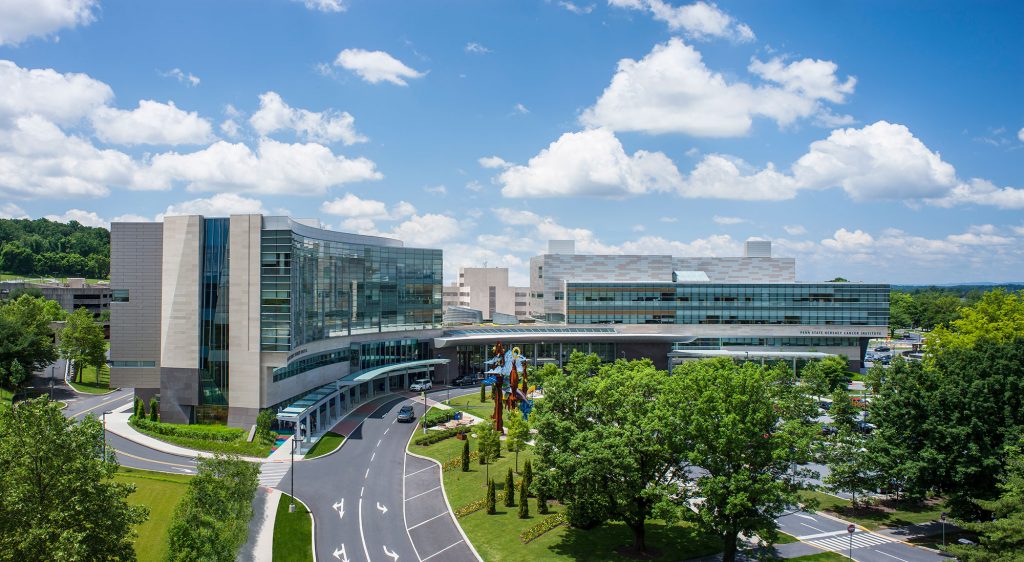
Penn State Health Children’s Hospital (left), Penn State Health Milton S. Hershey Medical Center (center) and Penn State Cancer Institute (right)
Penn State Health Milton S. Hershey Medical Center
500 University Dr., Hershey, Pa., 17033 (Derry Township, Dauphin County)
- The health system’s 611-bed flagship teaching and research hospital
- The only medical facility in Pennsylvania accredited as both an adult and a pediatric Level I (highest-level) trauma center
- Dedicated surgical, neuroscience, cardiovascular, trauma and medical intensive care units
- Accredited Life Lion critical-care transport providing more than 1,100 helicopter and approximately 750 ground ambulance transports per year
- More than 1,300 faculty members and more than 650 residents and fellows
- Approximately 29,000 admissions, 73,000 emergency department visits, 1.1 million outpatient visits and 33,000 surgical procedures annually
- Designated as a Magnet hospital since 2007
Learn more about Milton S. Hershey Medical Center
Penn State Health Children’s Hospital
600 University Dr., Hershey, Pa. 17033 (Derry Township, Dauphin County)
- An eight-story, 263,000-square-foot-facility built in 2013 and expanded in 2020
- 160 licensed pediatric beds, 26-bed pediatric intensive care unit and a 56-bed neonatal intensive care unit
- Level IV (highest-level) neonatal intensive care unit
- Level I quaternary (highest-level) pediatric intensive care unit
- Level I (highest-level) pediatric trauma center designation
- Intermediate care unit
- Dedicated pediatric operating rooms
- More than 150,000 pediatric outpatient visits, 20,000 pediatric emergency room visits, and approximately 5,000 pediatric patient discharges annually
Welcome to Hershey
More About Hershey
Interested in learning more about living and working in Hershey, Pa.? See details here:
Fellow wellness, including emotional, spiritual, social and physical health, is a crucial component to training and to becoming a professional, compassionate and resilient physician. Self-care is a skill which must be continually practiced and reinforced. Penn State College of Medicine and Penn State Health are committed to addressing wellness, with multiple resources readily available.
Institutional resources
Institutional Resources
Penn State Health and Penn State College of Medicine celebrate, embrace and support the diversity of all patients, faculty, staff, students and trainees.
Office for Diversity, Equity and Inclusion
In keeping with this, Penn State Health has an active Office for Diversity, Equity and Inclusion with various programs, networks and resource groups, including:
- Talks and lectures on diversity, equity and inclusion through the Inclusion Academy
- Regular events on topics such as eradicating racism and creating a culture of inclusiveness
- Many Business Employee Resource Groups (BERGs), including:
- Disability Business Employee Resource Group
- Interfaith Business Employee Resource Group
- LGBTQ+ Business Employee Resource Group
- Military and Veterans Business Employee Resource Group
- Multicultural Business Employee Resource Group
- NextGen Business Employee Resource Group
- Black Physician Professional Staff Association – Resource Group
- Hispanic Professional Association
- Asian Physician and Professional Staff Association
- International Workforce Inclusion
- Inclusion Academy
Learn more about the Penn State Health Office for Diversity, Equity and Inclusion
Learn more about the College of Medicine’s Office for Diversity, Equity and Belonging
Office for Culturally Responsive Health Care Education
The vision at Penn State College of Medicine and Penn State Health is to equip learners with the knowledge, skills and attitudes they will need to provide culturally excellent health care and research for an increasingly diverse U.S. population. The Office for Culturally Responsive Health Care Education was formed to help meet that goal.
Learn more about the Office for Culturally Responsive Health Care Education
Office for a Respectful Learning Environment
In addition, the institution does not tolerate discrimination, biases, microaggression, harassment or learner mistreatment of any kind, and any concerns are immediately addressed by the Office for a Respectful Learning Environment.
Learn more about the Office for a Respectful Learning Environment
Network of Under-represented Residents and Fellows
The Network of Under-represented Residents and Fellows (NURF) is a group of diverse residents and fellows representing all specialties. NURF’s goal is to promote cultural diversity in the residency programs through community involvement, mentorship with diverse faculty, professional networking and support for the recruitment of diverse medical students into the residency programs.
NURF is sponsored by the Penn State College of Medicine Graduate Medical Education Office and the Penn State Health Office for Diversity, Equity and Inclusion.
Latest News from Obstetrics and Gynecology




